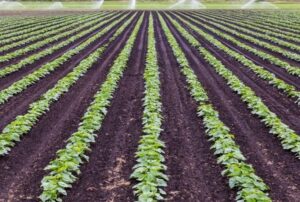The Economic Benefits of Sweetcorn Farming
Sweetcorn farming has long been a staple of agriculture in many regions around the world. Its versatility as a crop, along with its nutritional value, makes it an attractive option for farmers looking to diversify their operations. In addition to being a popular food source, sweetcorn offers a wide range of economic benefits for both small and large-scale farmers. This blog will explore how sweetcorn farming can contribute to local economies, create job opportunities, increase farm income, and drive agricultural innovation.
Organic natural farming is a sustainable agricultural practice that promotes the use of natural methods to cultivate crops and raise livestock without the use of synthetic chemicals or genetically modified organisms. This approach emphasizes the importance of soil health, biodiversity, and ecological balance to produce nutritious food while preserving the environment. By prioritizing organic methods such as crop rotation, composting, and integrated pest management, organic natural farming not only supports healthier ecosystems but also contributes to the well-being of consumers by reducing their exposure to harmful chemicals. This holistic approach reflects a commitment to sustainable practices that benefit both present and future generations, making organic natural farming a vital component of the movement towards a more environmentally conscious and health-focused food system.

1. High Market Demand and Profit Potential
One of the primary economic benefits of sweetcorn farming is the high demand for the crop in domestic and international markets. Sweetcorn is a versatile crop used in a wide range of products, including fresh corn, canned corn, frozen corn, and processed foods like popcorn and cornbread mixes. As consumers continue to demand more fresh and healthy foods, sweetcorn’s popularity grows, driving up market prices and making it a lucrative crop for farmers.
Sweetcorn is also a popular crop in both fresh and processed food markets, ensuring its demand throughout the year. Its relatively short growing cycle (usually 60 to 100 days depending on the variety) means that farmers can grow multiple crops within a single season, allowing them to capitalize on market demand at different times.
2. Diversification of Farm Income
Sweetcorn farming offers farmers a means to diversify their income streams. Many small-scale farmers rely on multiple crops to maintain a stable income, and sweetcorn serves as an ideal crop for rotation. Its ability to grow in various soil types and climates makes it a good option for regions with different growing conditions. By adding sweetcorn to their crop rotation, farmers can reduce their reliance on a single crop, spreading their financial risk and potentially increasing their profitability.
For larger commercial farms, sweetcorn farming can act as a complementary crop alongside other staple crops like wheat, soybeans, or rice. This diversification reduces the risk of crop failure from one particular crop, as sweetcorn can thrive even in less fertile soils or during unfavorable weather conditions.
3. Creation of Jobs and Local Economic Growth
Sweetcorn farming can significantly boost local economies, particularly in rural areas where farming is the primary source of income. The process of planting, cultivating, harvesting, and processing sweetcorn requires labor, creating job opportunities for local communities. Seasonal work opportunities in sweetcorn fields are common, providing employment for workers during planting and harvest seasons.
Additionally, as sweetcorn is often processed into a wide range of food products, the growth of the sweetcorn industry stimulates the food processing sector. This can lead to the creation of factories, packaging plants, and distribution centers, which provide further employment opportunities and stimulate economic growth in surrounding areas. The overall economic impact of sweetcorn farming extends beyond the fields, contributing to a more robust local economy.
4. Sweetcorn as a Cash Crop
Sweetcorn is considered a high-value cash crop. This means that farmers can sell sweetcorn for a premium price compared to other crops, especially when they have access to direct-to-market sales channels or premium markets. Sweetcorn can be sold fresh, canned, frozen, or processed into other products, all of which offer different price points. As the demand for organic and non-GMO products rises, sweetcorn grown under these categories can command even higher prices.
Furthermore, sweetcorn’s ability to grow in a variety of climates, including regions that are not traditionally known for large-scale agricultural production, means that farmers can enter lucrative markets even in areas where other crops may not thrive. For instance, in many tropical regions, sweetcorn farming provides an excellent opportunity to enter a competitive market with a high return on investment.
5. Promoting Agricultural Innovation
As sweetcorn farming grows in popularity, there is an increasing push for innovation in agricultural practices related to the crop. This includes the development of drought-resistant varieties, pest-resistant strains, and new techniques for irrigation, fertilization, and harvesting. Advances in biotechnology and crop genetics are expected to further enhance the economic benefits of sweetcorn farming by improving yield and reducing production costs.
Farmers are increasingly adopting modern farming techniques, such as precision agriculture, to optimize sweetcorn production. These technologies help farmers monitor soil health, manage water resources efficiently, and minimize the use of pesticides and fertilizers. By improving efficiency and reducing input costs, farmers can achieve higher profitability, contributing to the long-term sustainability of sweetcorn farming.
6. Positive Environmental Impact
While agriculture is often associated with environmental concerns, sweetcorn farming can contribute to more sustainable practices in some cases. For example, sweetcorn is often used as a cover crop in rotation systems. Cover crops improve soil health by reducing erosion, enhancing organic matter, and increasing soil fertility. By incorporating sweetcorn into crop rotations, farmers can improve the sustainability of their farming practices, which can lead to higher yields and lower costs in the long run.
Additionally, sweetcorn is an important component of the biofuel industry. In countries like the United States, sweetcorn is widely used to produce ethanol, which is blended with gasoline to reduce dependence on fossil fuels. The growing biofuel industry creates new opportunities for sweetcorn farmers and adds an additional revenue stream to their operations.
7. Global Trade and Export Opportunities
In addition to domestic markets, sweetcorn farming can open up lucrative export opportunities. Countries with an excess of sweetcorn production often export the crop to international markets, further driving demand and generating economic benefits. Exporting sweetcorn to regions with a high demand for the product can provide farmers with additional revenue, contributing to national economic growth as well.
For instance, countries like the United States, Mexico, and China are major exporters of sweetcorn, and many developing nations are also beginning to recognize its value as an export commodity. Export opportunities allow farmers to access larger markets, increasing the overall profitability of sweetcorn farming.
8. Low Input Costs and Efficient Use of Resources
Another economic advantage of sweetcorn farming is its relatively low input cost compared to other crops. While sweetcorn does require proper irrigation and nutrient management, it is less demanding than other crops such as rice or cotton. This means that farmers can grow sweetcorn with relatively low expenditures on fertilizers, pesticides, and other resources.
Sweetcorn is also a relatively water-efficient crop compared to some other large-scale crops, such as rice, which requires extensive water resources. By adopting efficient irrigation systems, farmers can minimize water usage and reduce costs. This makes sweetcorn farming an economically viable option even in regions with limited water resources.
9. Long-Term Sustainability
The economic benefits of sweetcorn farming extend beyond immediate profits. As farming practices become more sustainable and efficient, the long-term viability of sweetcorn as a cash crop is reinforced. Farmers who adopt innovative, sustainable practices can continue to reap the economic rewards of sweetcorn farming for years to come, ensuring that this crop remains a cornerstone of agricultural production.
Conclusion
Sweetcorn farming offers significant economic benefits to farmers, rural communities, and local economies. From its high market demand to its potential for diversification, sweetcorn provides farmers with opportunities for higher income, job creation, and greater agricultural innovation. By incorporating sweetcorn into crop rotations and utilizing modern farming practices, farmers can enjoy long-term economic success while contributing to more sustainable agricultural practices. With continued growth in global demand and the rise of biofuels, sweetcorn farming promises to remain a vital contributor to both local and global economies.














Post Comment